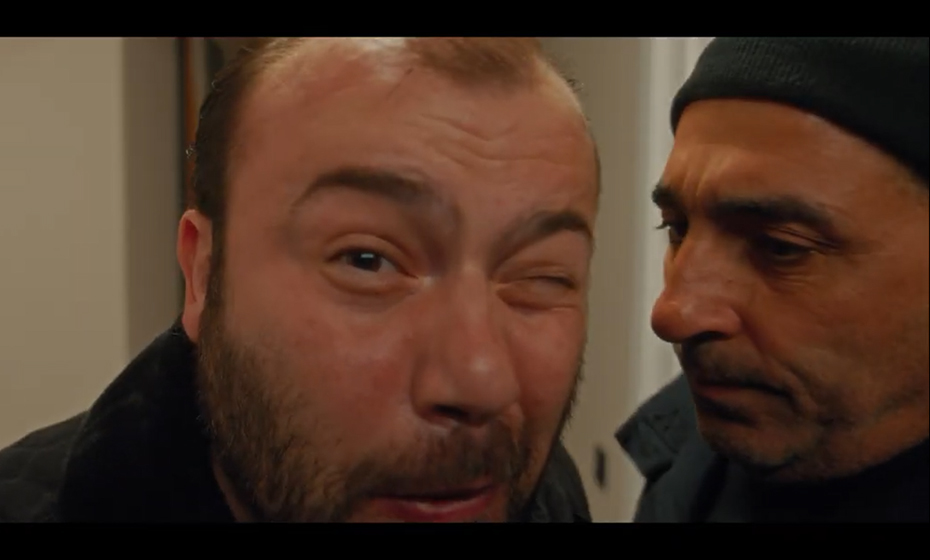Who hides behind the door?

“The Door” tragicomedy directed by Vusal Ahmadzadeh, at first sight, is a meticulously planned robbery story that fails due to unanticipated situations. Vafa (Sanubar Isgandarli) intends to rob the wealthy family for whom she worked and whose confidence she gained. In order to stay above suspicion, He recruits his close relatives – Vafadar (Rafael Isgandarov), a recently released from prison, and Vidadi (Nurlan Rustamov), a man whose life has spinned out of control, and who is on the verge of suicide – to aid in his robbery plan.
Dramaturgical structure of the story has been constructed upon a circular narrative (screenwriters Vusal Ahmadazadeh and Emin Afandiyev). The incomplete act introduced in the film’s first episode is resolved in the final sequence. In this 360-degree cyclical structure, Vafa, Vidadi and Vafadar attmept to make easy money to change their lives, in its turn, the viewer recognizes protagonists occasionally through flashbacks, but more predominantly via minimal dialogues and peripetias. The circle comprises individuals from different social spectrums, living beyond the reach of public visibility: the elderly woman Zemfira Abdulsamedova), who tries to serve everyone’s needs to escape from solitude, wearies with her advices; the courier (Emil Musayev) who compells to bear various people’s whims throughout the day; the popular singer (Kamran Aghabalayev); the father who unables to pay child support; those who can adapt to all circumustances; ones who lead double lives; those who feel innately entitled and superior; those who see poverty as a personal fault. Everyone remain oblivious to the truths concealed behind closed doors, envying one another’s fake worlds — like the beauty salon employer (Kamala Onur). However, one day all secrets are revealed precisely through the closed doors.
As the audience gets to know the characters, the smile which appeared at the beginning of the film gradually starts to fade away, and disappears upon Vidadi’s harsh fall to the floor. Vidadi is unable to discern the difference between committing suicide in daylight and at night.
But we are aware: in daylight, there is even a glimmer of hope for salvation; by night, none remains.
From the opening scene, the cinematographer Orkhan Mammadov signals our entry into a distorted, morally inverted world through the use of extreme angled shots. In this upside-down world, people with broad-shouldered body like wrestlers are coward and helpless (Kamran Aghabalayev masterfully conveyed the contradiction in the character of Janik), the loyal ones are faithless, and children want to kill their grandmother.
The sole door, which symbolizes Vidadi’s misguided choices and remains unclosed, is crooked. The only protagonist living by honest labor and protecting his rights and dignity – a Volt courier – is a thick-headed and grotesque character. This should be the norm in a world turned completely upside down. (I’m not sure if the screenwriters intentionally or unintentionally alluded to last year’s courier protest while crafting the scenario, but it certainly reminded me of that event.)
The main problem is that the excessive use of camera angle technique throughout the film—especially, in tandem with disjointed editing— feels monotonous, tiresome. In most cases, it is insuccessful. This belongs to close-ups as well. For instance, in the scene where Vafadar asks Vidadi if he betrayed him in his childhood, the camera makes them relatively low- angle shot. This shows that Vidadi is larger in scale than Vafadar in size.
However, Vidadi is actually in a difficult position here. He both fell into the curse of one’s own language, and was an protagonist under oppression. He should be framed from a lower angle. Just like the screenplay, the visual solution is required a certain dramaturgical logic and justification. In it’s absence, any given technique reveals inexperience, and at its lowest point, immediately exposes its sole intention to appear different.
Another problem in the film is the disconnection of the actors’ mutual performances. Particularly, the actors apparently are unaware of what or why they are doing, they simply repeat their lines in the episodes where the familiy secret was revealed and “Russian roulette” were played. They wait for one another to complete their lines. This causes unnatural pauses and disruption in the rhythm of the dialogue. Consequently, these scenes were not so much as convincing.
Taleh Yuzbayov seemingly intended to model his protagonist after Christian Bale’s role in the film “American Psycho”. But the actor failed to convincingly embody the protagonist’s specific selfishness, overconfidence arising from a sense of impunity. Accordingly, a didactic character has emerged.
However, all these are forgivable imperfections, considering that “The Door” is Vusal Ahmadzadeh’s debut feature film. As the Turks would say: “The first one bears no guilt.” What truelly matters is that he has something to address to the veiwer. Taking into account the packed theaters and the viewers’ reactions, it is clear that the director skillfully succeeded in both making the viewers and giving rise to thought.
Aygun Aslanli
